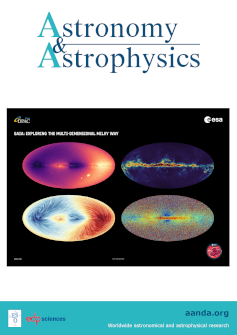Impact of the Tayler magnetic instability on the surface abundance of boron in massive stars
IF 5.8
2区 物理与天体物理
Q1 ASTRONOMY & ASTROPHYSICS
引用次数: 0
Abstract
Context. The surface abundances of massive stars show evidence of internal mixing, while asteroseismic data suggest that efficient angular momentum (AM) transport occurs in stellar interiors. It is of interest to find a consistent physical framework that is able to account for both of these effects simultaneously.Aims. We investigate the impact of the Tayler magnetic instability on the surface abundance of boron in massive B-type stars as predicted by rotating stellar models accounting for the advective nature of meridional currents.Methods. We used the Geneva stellar evolution code (GENEC) to compute models of 9, 12, and 15 M⊙ stars at different rotational velocities and with and without magnetic fields. We compared the surface boron abundances predicted by these models with those of observed B-type stars to test the consistency between AM transport constrained by asteroseismology and chemical mixing constrained by boron abundances.Results. We find that models with only hydrodynamic transport processes overestimate the amount of boron depletion for stars with high rotation rates, in disagreement with observational constraints. We show that this excessively high mixing efficiency is a direct consequence of the high degree of differential rotation predicted by purely hydrodynamic models. We thus conclude that, similarly to asteroseismic measurements, surface abundances of boron also indicate that a more efficient AM transport is needed in stellar radiative zones. We then studied the impact of the magnetic Tayler instability as a possible physical explanation to this issue. These magnetic models, which correctly reproduce asteroseismic constraints on AM transport, are found to be in good agreement with constraints on surface boron abundances, the evolutionary state, and the projected rotational velocity of moderately and fast-rotating B-type stars. We thus conclude that models accounting for the simultaneous impact of the magnetic Tayler instability and the advective nature of meridional currents offer a coherent and physically motivated theoretical framework that reproduces chemical mixing as revealed by boron abundances of fast-rotating stars and AM transport as constrained by asteroseismology. Finally, we note that at low rotational velocities (v sin i ≲ 50 km/s), models with magnetic fields do not predict sufficient depletion to be consistent with the observations, which are more compatible with non-magnetic models. This could suggest that the current prescriptions for transport by the Tayler instability somewhat overestimate the AM transport efficiency in slowly rotating B-type stars.泰勒磁不稳定性对大质量恒星中硼表面丰度的影响
上下文。大质量恒星的表面丰度显示了内部混合的证据,而星震数据表明,有效的角动量(AM)传输发生在恒星内部。寻找一个能够同时解释这两种效应的一致的物理框架是很有趣的。我们研究了泰勒磁不稳定性对大质量b型恒星表面硼丰度的影响,这是由考虑子午流平流性质的旋转恒星模型预测的。我们使用日内瓦恒星演化代码(GENEC)计算了9颗、12颗和15颗M⊙恒星在不同转速和有无磁场下的模型。我们将这些模型预测的表面硼丰度与观测到的b型恒星的表面硼丰度进行了比较,以检验星震学约束下的AM输运和硼丰度约束下的化学混合之间的一致性。我们发现,只有流体动力学输运过程的模型高估了高旋转速率恒星的硼耗竭量,这与观测约束不一致。我们表明,这种过高的混合效率是由纯流体动力学模型预测的高度微分旋转的直接结果。因此,我们得出结论,与星震测量类似,硼的表面丰度也表明,在恒星辐射区需要更有效的AM传输。然后,我们研究了磁泰勒不稳定性的影响,作为对这个问题的可能的物理解释。这些磁模型正确地再现了星震对AM输运的约束,与中、快速旋转b型恒星的表面硼丰度、演化状态和预计旋转速度的约束很好地吻合。因此,我们得出的结论是,考虑磁泰勒不稳定性和经向流平流性质同时影响的模型提供了一个连贯的、物理驱动的理论框架,该框架再现了由快速旋转恒星的硼丰度和受星震学约束的AM输运所揭示的化学混合。最后,我们注意到,在低转速(v sin i > 50 km/s)下,有磁场的模型预测的耗尽不足以与观测结果一致,这与非磁场模型更兼容。这可能表明,目前关于泰勒不稳定性传输的规定在某种程度上高估了慢旋转b型恒星的AM传输效率。
本文章由计算机程序翻译,如有差异,请以英文原文为准。
求助全文
约1分钟内获得全文
求助全文
来源期刊

Astronomy & Astrophysics
地学天文-天文与天体物理
CiteScore
10.20
自引率
27.70%
发文量
2105
审稿时长
1-2 weeks
期刊介绍:
Astronomy & Astrophysics is an international Journal that publishes papers on all aspects of astronomy and astrophysics (theoretical, observational, and instrumental) independently of the techniques used to obtain the results.
 求助内容:
求助内容: 应助结果提醒方式:
应助结果提醒方式:


